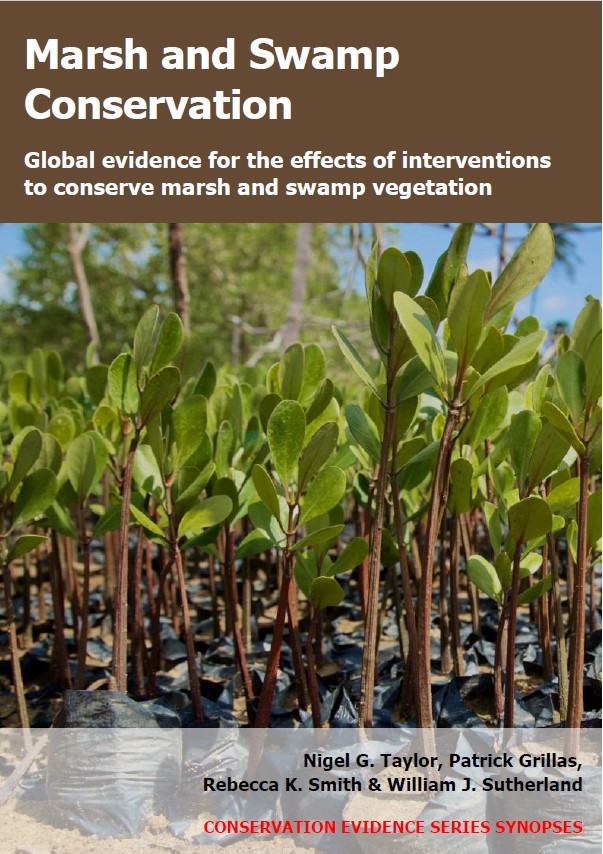Transplant or replace blocks of vegetation: freshwater marshes
-
Overall effectiveness category Likely to be beneficial
-
Number of studies: 4
View assessment score
Hide assessment score
How is the evidence assessed?
-
Effectiveness
60% -
Certainty
45% -
Harms
10%
Study locations
Supporting evidence from individual studies
A before-and-after study in 1980–1986 of a patch of freshwater marsh vegetation in England, UK (Worthington & Helliwell 1987) reported that transplanting vegetation from one site to another (then grazing, cutting and pulling up weeds) had little long-term effect on plant species richness. Unless specified, statistical significance was not assessed. The vegetation contained 54 species before transplanting and 49 species six years after. Thirty-six species were present both before and after transplanting. Small-scale richness was significantly higher one year after transplanting (16 species/m2) than before (11 species/m2), but returned to approximately 11 species/m2 after six years. The most frequently recorded species before intervention were clustered dock Rumex conglomeratus (in 100% of quadrats), creeping buttercup Ranunculus repens (92%) and yellow iris Iris pseudacorus (75%). The most frequently recorded species after intervention were tufted grass Holcus lanatus (92%) and yellow iris (83%). Methods: In late 1980, around 1.5 ha of marsh vegetation (along with 2.8 ha of other vegetation) was transplanted from one site earmarked for gravel mining. The new site, 400 m away, was excavated to suitable elevations, then 6-m2 blocks of vegetation and soil were transplanted. Post-transplant management involved annual grazing, pulling up docks Rumex spp. and intermittent cutting. Pumps maintained a high water table. The marsh vegetation was surveyed in twelve 1-m2 quadrats before (October 1980) and after (October 1981 and 1986) intervention.
Study and other actions testedA replicated, paired, controlled study in 1992–1993 in five freshwater marshes undergoing restoration in New York State, USA (Brown & Bedford 1997) found that plots of transplanted marsh vegetation contained a more wetland-characteristic plant community, with more and greater cover of wetland species, than plots without transplants for up to two growing seasons. After one growing season, transplanted plots contained a plant community more characteristic of wetland conditions than plots without transplants (data reported as a wetland indicator index). The transplanted plots also contained more and greater cover of wetland plant species (3.7 species/plot; 50% cover) than plots without transplants (2.0 species/plot; 19% cover). After two growing seasons, the transplanted plots still had greater cover of wetland plants (99%) than plots without transplants (54%), but the other metrics did not significantly differ between treatments (e.g. 5.1 vs 2.8 wetland plant species/plot). Methods: In May 1992, thirty 0.25-m2 plots were established across five recently rewetted sites (drained for ≥40 years previously). In 15 plots (three plots/site), 15 cm of topsoil was removed and replaced with sods of soil and vegetation from nearby remnant marshes. The other 15 plots (three plots/site) were left undisturbed. Plant species and cover were recorded in autumn 1992 and 1993.
Study and other actions testedA study in 1994–1997 in a floodplain wet prairie in Kansas, USA (Fraser & Kindscher 2001) reported >90% survival of transplanted wetland vegetation sods after four growing seasons, and found that the area of surviving sods increased. After four growing seasons, 97 of 107 transplanted sods were still alive. Two sods were confirmed as dead. The other eight sods were not relocated. Surviving sods dominated by prairie cordgrass Spartina pectinata covered 1.6 m2 on average and surviving sods dominated by spikerush Eleocharis macrostachya covered 26 m2 on average. All sods were 0.28 m2 when transplanted. For both species, the final area of sods was affected by elevation/moisture levels (see original paper). Methods: In spring 1994, sods of perennial wet prairie vegetation were cut from a wet prairie using a mechanical tree spade. The sods were placed in a newly created wet prairie site, with similar soils to the donor site, within one hour. Survival of all sods, and the area of 27 cordgrass-dominated and 18 spikerush-dominated sods, were monitored each October between 1994 and 1997.
Study and other actions testedA replicated, site comparison study in 1999–2001 in a floodplain wet prairie in Kansas, USA (Fraser & Kindscher 2005) reported 90% survival of transplanted prairie cordgrass Spartina pectinata sods over three growing seasons, found that smaller sods increased in size and area, and found that transplanted cordgrass was shorter and less dense than in reference prairies. Sixty plots were planted with 1–20 cordgrass sods, with a total area of about 0.65 m2/plot. After three growing seasons, 90% of all transplanted cordgrass sods contained at least one living stem (range 73–100% for different initial sod sizes and planting elevations). The total area of prairie cordgrass had increased in plots planted with small sods (to 3.6 m2/plot) or medium sods (to 1.0 m2/plot) but had decreased in plots planted with one large sod (to 0.4 m2/plot). This reflected changes in the average size of individual sods (see original paper for data). After three growing seasons, prairie cordgrass was shorter and less dense in planted sods (127 cm tall; 91 stems/m2) than in pristine or source prairies (184–192 cm tall; 257–303 stems/m2). Methods: In June 1999, five-hundred cordgrass sods were transplanted from roadside areas to a recently restored wet prairie (historically farmed, sown with mixed prairie seeds in April 1999). Twenty 400-m2 plots were planted with each sod number/size combination (twenty 0.03-m2 sods; four 0.17-m2 sods; or one 0.65-m2 sod). Plots had varying elevations (moisture levels). Sods were monitored in September 1999, 2000 and 2001. Cordgrass height and density were also surveyed in nearby pristine wet prairies and source roadside prairies.
Study and other actions tested
Where has this evidence come from?
List of journals searched by synopsis
All the journals searched for all synopses
This Action forms part of the Action Synopsis:
Marsh and Swamp Conservation
Marsh and Swamp Conservation - Published 2021
Marsh and Swamp Synopsis





)_2023.JPG)














